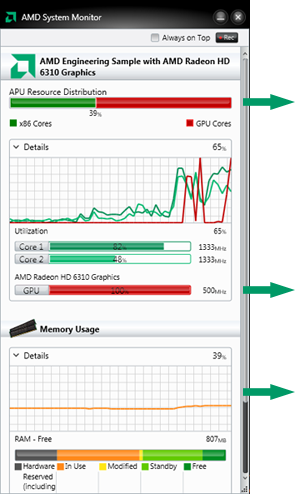
- #Amd system monitor how to
- #Amd system monitor install
- #Amd system monitor Pc
- #Amd system monitor free
There are dozens of temperature-monitoring programs out there, but for most users, I recommend Core Temp (Opens in a new window).
#Amd system monitor how to
How to Set Up Two-Factor AuthenticationĬore Temp provides as much information as you need.
#Amd system monitor Pc
#Amd system monitor free
How to Free Up Space on Your iPhone or iPad.How to Block Robotexts and Spam Messages.Have your say about this article or ask questions via the feedback form below.

That’s all for now! In this article, we have shared the useful command-line tools for viewing CPU and GPU temperatures in a Ubuntu system. CoreFreq – A Powerful CPU Monitoring Tool for Linux Systems.Cpustat – Monitors CPU Utilization by Running Processes in Linux.9 Useful Commands to Get CPU Information on Linux.Limit CPU Usage of a Process in Linux with CPULimit Tool.You might also like to read these useful related articles. Show Intel Core Information with Temperature Once installed, run i7z with root privileges as shown.
#Amd system monitor install
You can install it on your Ubuntu system by running the following command. I7z is a tiny command-line utility that reports Intel Core i7, i5, i3 CPU information including temperatures. Then click on sensors to view sensors information as shown in the following screenshot. To launch the GUI app, simply run the following command or search for ‘ System Profiler and Benchmark’ in the system menu or Dash and open it. $ sudo apt install hardinfoĪfter the installation is complete, you can launch hardinfo to view devices’ information by running the following command. To install the hardinfo package on your Ubuntu Linux system, run the following command. It features comprehensive reports on system hardware and allows for the generation of HTML reports on your system’s hardware. Hardinfo is a lightweight system profiler and benchmark tool designed for hardware analysis and report generation. Recommended Read: Psensor – A Graphical Hardware Temperature Monitoring Tool for Linux 3. Once detected, you can run the following command to check CPU temperature, GPU temperature, fan speed, voltage, etc. Then you can run the following command to detect all sensors on your system. It comes pre-installed some Linux distributions such as Ubuntu by default, otherwise install it as shown. Sensors is a simple command-line utility that displays the current readings of all sensor chips including the CPU. Glances – Monitor CPU and GPU Temperature 2. Once you have installed it, start Glances and press f key to view sensors information. To install Glances on your system, use curl or wget command as shown. There are various methods to install Glances on your system, but the preferred way of installing glances is using an auto-install script, which will install the latest production-ready version. One of its intriguing features is the webserver mode which allows you to access it via a web browser to remotely monitor your Linux server.

It can display information from sensors using the psutil and/or hddtemp tools. Glances is a cross-platform, advanced and popular real-time system monitoring tool that uses the psutil library to gather information from various system resources. In this article, we will share some useful command-line tools to help you keep a close eye on the temperature of your CPU and GPU. So it is important to monitor your system’s CPU temperature to avoid damaging it as a result of overheating. Recommend Read: 10 Useful Commands to Collect System and Hardware Information in Linux Besides, it can also cause thermal throttling especially when the fan is not providing adequate cooling. Sensitive computer components such as CPUs have a finite lifespan and running them at a temperature that exceeds a certain limit (or at higher temperatures generally) can shorten it. The CPU or GPU temperature depends entirely on the usage of running programs or applications.


 0 kommentar(er)
0 kommentar(er)
